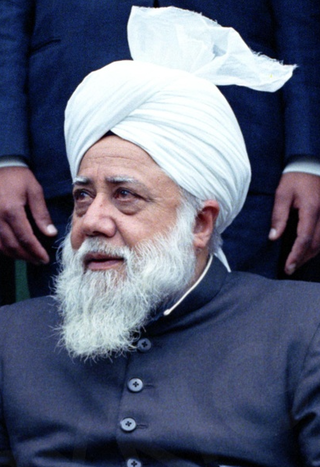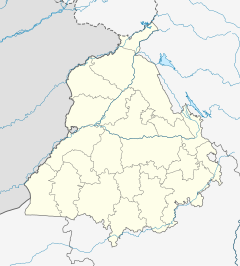Rabwah, officially known as Chenab Nagar, is a city in Chiniot, Punjab, Pakistan on the bank of Chenab River. It was the headquarters of the Ahmadiyya Muslim Community from September 20, 1948 when the community relocated from Qadian, India to the newly created state of Pakistan, where the Community leased the area of present-day Rabwah from the government to establish its home. This continued until 1984 and the establishment of Ordinance XX. In 1984, the headquarters were moved to the United Kingdom with Mirza Tahir Ahmed, first to London and then in 2019 to the Islamabad compound in Tilford, Surrey.

Qadian is a city and a municipal council in Gurdaspur district, north-east of Amritsar, situated 18 kilometres (11 mi) north-east of Batala city in the state of Punjab, India. Qadian is the birthplace of Mirza Ghulam Ahmad, the founder of the Ahmadiyya movement within Islam. It remained the headquarters of the Ahmadiyya movement until the Partition of India in 1947.

Eid Mubarak is an Arabic term that means “Blessed feast/festival'”. The term is used by Muslims all over the world. Internationally Muslims use it as a greeting on the feast. In the social sense, people usually celebrate Eid al-Fitr after Ramadan and Eid al-Adha in the month of Dhul Hijjah. Some state that this exchange of greetings is a cultural tradition and not part of any religious obligation.

Mirza Nasir Ahmad was the third Caliph of the Ahmadiyya Muslim Community. He was elected as the third successor of Mirza Ghulam Ahmad on 8 November 1965, the day after the death of his predecessor and father, Mirza Basheer-ud-Din Mahmood Ahmad.

Hakeem Noor-ud-Din was a close companion of Mirza Ghulam Ahmad, the founder of the Ahmadiyya Movement, and his first successor and first Ahmadiyya caliph since 27 May 1908.

The Fazl Mosque also known as The London Mosque, is the first purpose-built mosque in London, England. It was opened on 23 October 1926 in Southfields, Wandsworth. At a cost of £6,223, the construction of the mosque and the purchase of the land on which it stands, was financed by the donations of Ahmadi Muslim women in Qadian, Punjab, British India, with support from the British Muslim convert Khalid Sheldrake. Between 1984 and 2019 the Fazl Mosque was the residence of the caliphs of the Ahmadiyya Muslim Community, and therefore its de facto international headquarters. The administrative headquarters now lies at the site of the Islamabad, Tilford.

Mirza Masroor Ahmad is the current and fifth leader of the Ahmadiyya Muslim Community. His official title within the movement is Fifth Caliph of the Messiah. He was elected on 22 April 2003, three days after the death of his predecessor Mirza Tahir Ahmad.

The Ahmadiyya branch of Islam has been subjected to various forms of religious persecution and discrimination since the movement's inception in 1889. The Ahmadiyya Muslim movement emerged within the Sunni tradition of Islam and its adherents believe in all of the five pillars and all of the articles of faith required of Muslims. Ahmadis are considered non-Muslims by many mainstream Muslims since they consider Mirza Ghulam Ahmad, the founder of the movement, to be the promised Mahdi and Messiah awaited by the Muslims.

The Aqsa Mosque in Rabwah is the main and largest mosque of the Ahmadiyya Muslim Community in Pakistan. Its foundation stone was laid down in 1966. The mosque was inaugurated on 31 March 1972 by the head of the worldwide community, Mirza Nasir Ahmad. The building can accommodate up to 20,000 worshippers.

Jalsa Salana is a formal, annual gathering of the Ahmadiyya Muslim Community. It was initiated in 1891 by Mirza Ghulam Ahmad, the founder of the community, in Qadian, India. Usually, the gathering spans three days, beginning with the flag hoisting ceremony following the Friday Sermon. Although the convention held in the UK is deemed to be the major and 'international Jalsa' attended by Ahmadis from across the world, Ahmadis in other countries hold their own national Jalsas, sometimes attended by the Khalifatul Masih.

Ahmadiyya is an Islamic branch in Indonesia. The earliest history of the community in Indonesia dates back to the early days of the Second Caliph, when during the summer of 1925, roughly two decades prior to the Indonesian revolution, a missionary of the Community, Rahmat Ali, stepped on Indonesia's largest island, Sumatra, and established the movement with 13 devotees in Tapaktuan, in the province of Aceh. The Community has an influential history in Indonesia's religious development, yet in the modern times it has faced increasing intolerance from religious establishments in the country and physical hostilities from radical Muslim groups. The Association of Religion Data Archives estimates around 400,000 Ahmadi Muslims, spread over 542 branches across the country.

Ahmadiyya is a growing minority Islamic sect in Bangladesh. Although the first Bengalis to join the sect did covert during the lifetime of Mirza Ghulam Ahmad, the sect was first established as a community in the region of Bengal in 1913 by Syed Muhammad Abdul Wahed, during the Caliphate of Hakeem Noor-ud-Din. As the worldwide community is itself is an highly organised group under the Caliph, the national community works under the name Ahmadiyya Muslim Community Bangladesh or Ahmadiyya Muslim Jama'at Bangladesh. There are an estimated 100,000 Ahmadis in the country as of 2004.

Jāmi’ah al-Ahmadīyyah is an International Islamic seminary and educational institute with campuses in Pakistan, United Kingdom, India, Ghana, Canada, Germany, Nigeria, Indonesia, Bangladesh, Malaysia, Tanzania, Sri Lanka, Sierra Leone, and Kenya. In addition, there are affiliated Mu'alameen centers in Pakistan and Madagascar. Founded in 1906 as a Section in Madrassa Talim ul Islam by Mirza Ghulam Ahmad of Qadian, the founder of the Ahmadiyya Muslim Community, it is the main centre of the Ahmadiyya Muslim Community for Islamic learning.

The Ahmadiyya Muslim Community was established in United Kingdom with the pioneering efforts of Chaudhry Fateh Muhammad Sial, who arrived in London in July in 1913. Sial was the first missionary sent overseas by the Ahmadiyya Muslim Community and was under the direction of Hakeem Noor-ud-Din, the first caliph of the movement.

Ahmadiyya is an Islamic movement in Australia, first formally founded in the country in the 1980s, during the era of the fourth caliph. However, the history of the Community dates back to the early 20th century, during the lifetime of the founder of the movement, Mirza Ghulam Ahmad, with the first contacts arising as a consequence of Australians travelling to British India, and also as a consequence of early, "Afghan" camel drivers settling in Australia during the mid to late 19th century. Today there are at least four Ahmadi mosques in four of the six Australian states, representing an estimated 6,000-8,000 Australian Ahmadis in the country.

The Aqsa Mosque is the largest and oldest mosque of Qadian, India. It is situated inside the compound of the ancestrial house of Mirza Ghulam Ahmad, close to the White Minaret, and located in the Ahmadiyya Mohallah of Qadian.

Al-Nour Mosque is a mosque in Abbassia, Cairo, Egypt. It is among the landmarks of the neighborhood and the largest mosques in the city with several different halls for multi-purposes. It conducts social activities and sporting events as well. The mosque contains other facilities such as library.

The Mubarak Mosque is a mosque in Tilford, Surrey, England, on the site of the international headquarters of the Ahmadiyya Muslim Community, formally known as Islamabad, Tilford. It was inaugurated on Friday 17 May 2019 by Mirza Masroor Ahmad, the fifth caliph of the Ahmadiyya Muslim Community.

Ahmadiyya Muslim Community is an Islamic branch in Poland, under the spiritual leadership of the caliph, Mirza Masroor Ahmad. It was registered in Poland on December 3, 1990, and since then has the status of a religious association in the territory of the Republic of Poland. In 1991, the Community purchased a detached house with a plot of land in Włochy, Warsaw. The house was converted into a Mission House and mosque premises. The community has around 100 members in Poland













